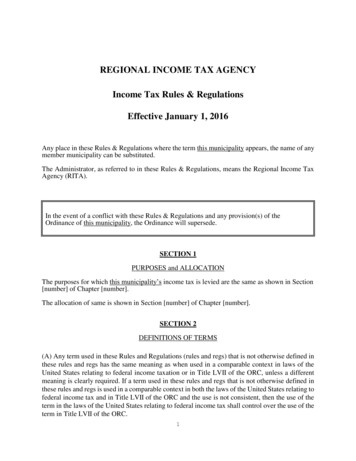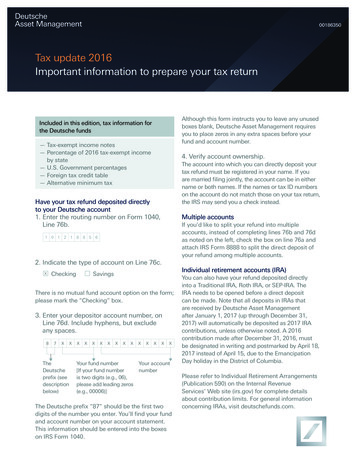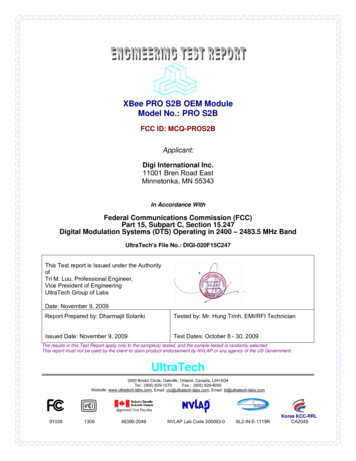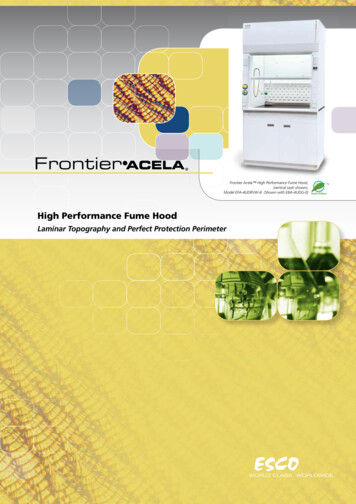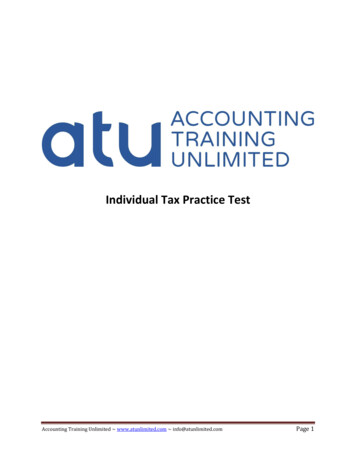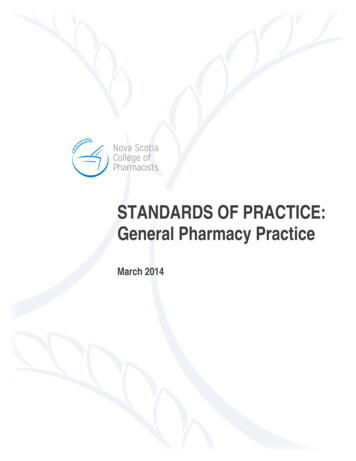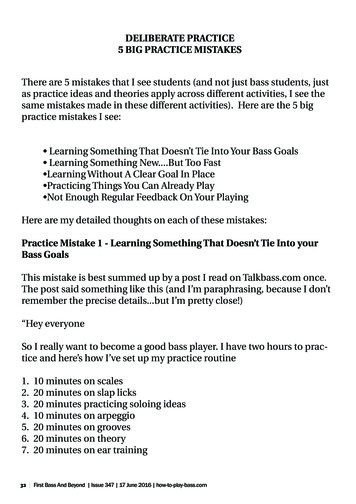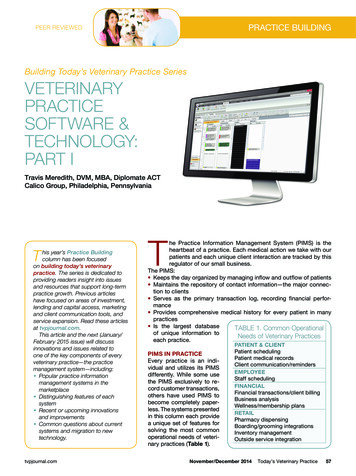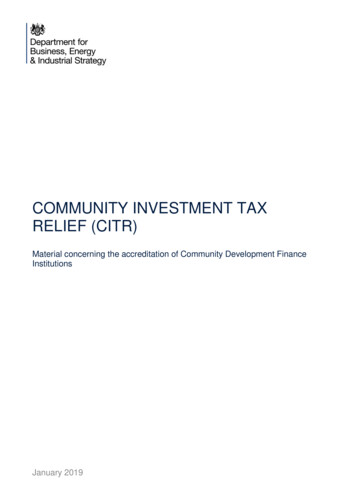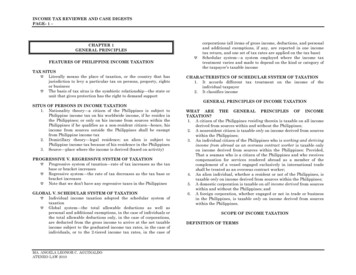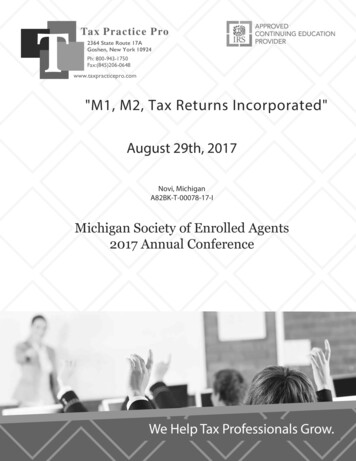
Transcription
Tax Practice Pro2364 State Route 17AGoshen, New York 10924Ph: m"M1, M2, Tax Returns Incorporated"August 29th Novi, MichiganA82BK-T-00078-17-IMichigan Society of Enrolled Agents2017 Annual ConferenceWe Help Tax Professionals Grow.
"M1, M2, Tax ReturnsIncorporated"August 29th, 2017 Novi,MichiganIRS Program No. A82BK-T-00078-17-I4 credit hours of Federal Tax LawApproved for Enrolled Agents & Other Tax Return PreparersTax Practice Pro, Inc.2364 State Route 17AGoshen, NY 10924800‐943‐1750john@taxpracticepro.comAll Tax Practice Pro Inc. products are intended to provide general information about the subjectmatter covered. They are not meant to provide legal opinions, offer advice, or serve as a substitutefor advice by licensed, legal professionals. Our products are sold with the understanding that TaxPractice Pro, Inc. is not engaged in rendering legal or other professional services.Tax Practice Pro Inc. does not warrant that the information in any of our products is complete oraccurate, and does not assume and hereby disclaims any liability to any person for any loss or damagecaused by errors, inaccuracies or omissions, or usage of these products.Laws and interpretations of those laws change frequently and the subject matter of our products hasimportant legal consequences. If not understood, legal, tax, or other counsel should be consulted. Allrisk of loss or damage is solely that of the user of our forms and the company disclaims any liabilitythereof.NOTICE: AUDIO AND VIDEO RECORDING OF ALLTAX PRACTICE PRO EVENTS IS PROHIBITEDwww.taxpracticepro.com 2017 Tax Practice Pro, Inc.1August 29, 2017Michigan Society of Enrolled Agents
Very special thanks to Don Overstreet, EA, for his technical review ofthe text and valuable suggestions in making it more readable.As always, thanks to my proofreaders Susan Anderson, EA GayleSheeley, Mary Sheeley EA, Marta Milczarek-McDonald, EA,Michelle McBride, EA, and Marie Zumwalt, EAAUTHOR’S NOTE: The purpose of this seminar is to present and discussselected issues related to the operation of Corporations which elected taxationunder sub-chapter S of the Internal Revenue Code. Some of the issuespresented deserve their own three-hour seminar. Further, a course of thisnature does not allow a comprehensive presentation covering all possiblescenarios related to the subject matter presented.SUPPLEMENTAL MATERIAL: Throughout this text I will reference externalarticles and miscellaneous documents. In the past, the author needed to pickand choose what supplemental materials to provide, balancing education needswith reproduction costs and manageability of the handouts.In order to provide you with a maximum of supplemental materials and introduceyou to the use of so-called client portals in your practice, I have made a portalavailable in our secure file room. This portal contains all of today’s referencedhand outs and a copy of this presentation. To access the portal, navigate to Click on "Documents from Preparer" folder on the left side panel)Your username is: ScorpCEYour password is: Taxis#1Due to digital delivery of materials by the Michigan Society of Enrolled Agents,the portal material is also included on your USB drive.www.taxpracticepro.com 2017 Tax Practice Pro, Inc.2August 29, 2017Michigan Society of Enrolled Agents
Refresher of the BasicsNolo’s Plain Law Dictionary defines a corporation as “A legal structureauthorized by state law that allows a business to organize as aseparate legal entity from its owners. A corporation is often referred toas an "artificial legal person," meaning that, like an individual, it canenter into contracts, sue and be sued, and do the many other thingsnecessary to carry on a business. One advantage of incorporating isthat a corporation's owners (shareholders) are legally shielded frompersonal liability for the corporation's liabilities and debts (unpaid taxesare often an exception) 1As tax professionals, we often refer to “C” Corporations and “S”Corporations as if these were two distinct forms of legal entity. Inreality, an “S” Corporation refers to a special election available to smallcorporations which allows them to be taxed under Subchapter “S” ofthe Internal Revenue Code. But under the law, a corporation is acorporation is a corporation.Corporations which properly elect and are approved for taxation underSubchapter S pass corporate income, losses, deductions and creditsthrough to their shareholders for federal tax purposes. Shareholders ofS corporations report the flow-through of income and losses on theirpersonal tax returns and are assessed tax at their individual incometax rates. 2Why choose an “S” Corp?An “S” Corp offers a single level of tax. This is referred to as a “passthrough” entity. The corporation will generally3 not pay income tax, butrather the profit or loss and other attributes are included on the taxreturn(s) of the shareholders. A “C” Corp may encounter doubletaxation, in that when it distributes earnings to shareholders in the formof a dividend, these payments are not deductible by the corporationwhile they are taxable to the shareholder. [Note that some states es-&-Self-Employed/S-Corporations3Internal Revenue Code Section 13792www.taxpracticepro.com 2017 Tax Practice Pro, Inc.3August 29, 2017Michigan Society of Enrolled Agents
certain localities, such as New York City, do not recognize “S”elections].One might also elect S status if the corporation is a Personal ServiceCorporation (PSC). A corporation is a personal service corporation ifit meets all of these criteria4:1. The Corporation’s principal activity is performing personalservices in the fields of accounting, actuarial science,architecture, consulting, engineering, health (includingveterinary services), law, and the performing arts.2. Its employee-owners substantially perform the servicesmentioned above. This requirement is met if more than 20% ofthe corporation's compensation cost for its activities ofperforming personal services during the year is for personalservices performed by employee-owners.3. Its employee-owners own more than 10% of the fair marketvalue of its outstanding stock5.A personal service corporation’s profits are subject to a flat 35% federalincome tax. Of particular interest to enrolled agents is the tax courtdecision in Rainbow Tax Service, Inc. v. Commissioner of InternalRevenue6, which held that tax return preparation and bookkeepingservices constitute accounting services for purposes of IRC section448(d)(2).S-Corp losses are passed through to the shareholder(s) and aretreated as ordinary loss. In the case of a “C” Corp these losses arecarried forward either until the corporation incurs taxable income or 20years, whichever comes first.4Internal Revenue Code Section 269A(b)Internal Revenue Code Section 469(j)(2)6Rainbow Tax Service, Inc,, 128 T.C. No. 5 (2007)5www.taxpracticepro.com 2017 Tax Practice Pro, Inc.4August 29, 2017Michigan Society of Enrolled Agents
Some disadvantages to the “S” election include:1. The 50%/75%/100% exclusion of gain on the sale of “qualifiedsmall business stock” under Internal Revenue Code section1202 is not available to S-Corps. The ultimate exit strategy ofthe client needs to be considered here.2. While not deeply addressed in this seminar, the deductibility offringe benefits of S-Corp shareholders owning more than 2% ofthe stock of the corporation is limited, while there are fewrestrictions on the deductibility of fringe benefits for shareholderemployees of “C” corps.3. Uncertainty of the tax treatment of health insurance for greaterthan 2% shareholders after December 31, 2015.74. Stock in an “S” Corp can only be transferred to eligibleshareholders (US resident individuals or Citizens, estates,certain trusts, certain pension plans and certain charities).5. The “S” corp. cannot have more than 100 shareholders, althoughthere are some approved holding company structures which cancircumvent this8 9. These restrictions can limit the sources ofcapital for the corporation.6. In a “C” Corp, profits can be held, within some limits10, until theshareholder is in a lower tax bracket. With an S-Corp, income ispassed through to the shareholder(s) each year regardless ofwhether distributed or not.7Notice 2015-17, question 2Rev. Ruling 94-439Letter Ruling 8536017 (1985)10Internal Revenue Code Section 5318www.taxpracticepro.com 2017 Tax Practice Pro, Inc.5August 29, 2017Michigan Society of Enrolled Agents
To qualify for S corporation status, the corporation must meet thefollowing requirements:1. Be a domestic corporation;2. Have only allowable shareholders including individuals, certaintrusts and estates. They may not include partnerships,corporations or non-resident alien shareholders;3. Have no more than 100 shareholders;4. Have one class of stock;5. Not be an ineligible corporation i.e. certain financial institutions,insurance companies, and domestic international salescorporations.www.taxpracticepro.com 2017 Tax Practice Pro, Inc.6August 29, 2017Michigan Society of Enrolled Agents
Error #1: Failing to Properly ElectAs practitioners we have all experienced the ‘your corporation does nothave a valid ‘S’ election in effect’ letter. When else would the electioncome under scrutiny by the Internal Revenue Service? It is one of thefirst items an examiner should check. Internal Revenue ManualSection 4.35.2.2.2.C states to the examiner:S corporation election -- The election should be reviewed toverify that (1) all shareholders at the date of the election signedthe election and that the number of shareholders at the date ofthe election did not exceed the maximum number ofshareholders, (2) all shareholders were individuals who wereU.S. citizens or residents, estates, certain types of trusts, IRCsection 501(c)(3) organizations or employee stock ownershipplan (ESOP), (3) the corporation has only one class of stock and(4) the corporation is not an ineligible corporation as defined inIRC section 1361(b)(2). 11Failure to properly electIn order to elect S corporation treatment, the corporation mustsubmit Form 2553, Election by a Small Business Corporation, signedby all the shareholders. This form is due by the 75th day of anysubsequent year.A proper election made within the first 2 ½ months (actually 75calendar days) of the corporation’s tax year is effective from the firstday of that year.An election made after the first 75 days of the corporation’s tax yearwill become effective the first day of the SUBSEQUENT tax year.The Form 2553 must be signed by all shareholders holding shares atthe time of the election.11http://www.irs.gov/irm/part4/irm 04-035-002.html or section 4.35.2.2.2.C of the Internal RevenueManual as available on August 31, 2016www.taxpracticepro.com 2017 Tax Practice Pro, Inc.7August 29, 2017Michigan Society of Enrolled Agents
Failure to timely electGenerally speaking, no new client will arrive at your office andannounce, “Hi, I failed to file form 2553 three years ago. Can youplease read the relevant literature and resolve the matter for me beforewe file my tax returns?” Rather, the new client arrives at your officeand announces they need you to prepare their “S-Corp taxes”, or that“my attorney incorporated me”. My current favorite statement is “I wentto Legal Zoom .”Usually, the tax professional learns that the Corporation failed to timelyfile the “S” election either when the irate client comes into the officewith a rejected income tax return filing and a letter entitled “Notice ofInvalid S-Election”, or when the e-filed tax return or extension isrejected due to a ‘database mismatch”.At this point the client has two choices:1. Re-file the rejected tax return as a “C”-Corp. In this case, theclient will likely also need to file the subsequent year as a C-Corptoo. This is because assuming the rejected return is for tax year2015 and was filed by March 15, 2016, the client learns of theinvalid S-Election too far into 2016 to elect for 2016.2. Request relief from the Internal Revenue Service by requestingso-called “late election”. Prior to September, 2013, there wereFIVE revenue procedures to consider for relief when presentedwith an invalid S-Election. Effective with the release of RevenueProcedure 2013-30, the IRS updated and consolidated theprocedures for requesting relief for a number of missed-deadlineelections related to sub-chapter S-Corporations.Most paid research services contain a complete set of RevenueRulings. Alternatively, you can Google “Revenue Ruling 2013-30” fora copy of the Ruling. A copy of the 30-page ruling is available in theportal. Pages 12 and 13 contain useful flow-charts for understandinghow Revenue Procedure 2013-30 can assist you.www.taxpracticepro.com 2017 Tax Practice Pro, Inc.8August 29, 2017Michigan Society of Enrolled Agents
If the Corporation does not qualify for any of the automatic reliefprovisions discussed in Revenue Procedure 2013-30, or if automaticrelief is subsequently denied, the shareholders can pursue a privateletter ruling. A private letter ruling (PLR) is a written response by IRSChief Counsel to a taxpayer providing interpretation of tax law to aspecific set of facts provided by the taxpayer. A PLR can also be arequest for relief of a late election. In either case, if the taxpayer fullyand accurately describes the situation, the PLR is binding on the IRSfor the taxpayer making application for the PLR. The PLR is not aprecedent and not binding on other taxpayers. 12These can beexpensive both for the professional preparation of the case and thefiling fee to the Internal Revenue Service. (The fee for a PrivateLetter Ruling in this case is potentialy 28,300 for requestsreceived after February 1, 2017.13)Internal Revenue Bulletin2017-1 includes a sample format for a Private Letter Rulingand a checklist to help ensure completeness. The December2010 NATP Taxpro Monthly contains an excellent article onPrivate Letter Rulings (a copy can be found on the portal).Portal: We won’t spend time on the mechanics of preparing one of these letters. Acompleted case is included in the portal for your reference.Portal: I placed a copy of Revenue Ruling 2013-30 in the portal for your convenience.12NATP Tax Pro Monthly, December 2010, National Association of Tax Practitioners, Inc.13Internal Revenue Bulletin 2017-1. These fees are subject to change each year, and the practitioner isadvised to confirm the most recent fee prior to submitting the request for a Private Letter Ruling.www.taxpracticepro.com 2017 Tax Practice Pro, Inc.9August 29, 2017Michigan Society of Enrolled Agents
BEST PRACTICE: Using the text of the applicable section of the Revenue Ruling, cutand paste the requirements into your letter requesting relief. The Service employeeassigned to review your client’s request for relief case may not have the time to checkevery fact, or even to review the Revenue Ruling to refresh themselves on the facts. Themost successful letters:o First, outline the problem and explain the outcome you desireo Identify the part of the Internal Revenue Manual or Revenue Ruling thatallows the reliefo Lists each of the requirements to obtain the relief, and explains how thetaxpayer has met that relief – don’t expect the Service employee to drawthe conclusion, you need to tell them! (This is what Adam Schiff alwaystold Jack McCoy about juries, anyway).o Include a Power of Attorneyo Identify all attachments (Exhibit A, etc.) and reference the attachmentsfrom your lettero Close the letter with an offer that the agent can call you – sometimes afax or phone call can resolve a misunderstandingo Send the letter Certified Mail, Electronic Return Receipt or through aservice from a Designated Private Delivery Service which qualifies asproof of delivery.o Contact Practitioner Priority Service (1-866-860-4259 option 3) in about21 days to ensure the item is received and assigned to an examinero Contact Practitioner Priority Service 4 weeks after that call to obtain thestatus of the case. If you are not satisfied with the status, ask for a‘referral ’.www.taxpracticepro.com 2017 Tax Practice Pro, Inc.10August 29, 2017Michigan Society of Enrolled Agents
www.taxpracticepro.com 2017 Tax Practice Pro, Inc.11August 29, 2017Michigan Society of Enrolled Agents
www.taxpracticepro.com 2017 Tax Practice Pro, Inc.12August 29, 2017Michigan Society of Enrolled Agents
BEST PRACTICES FOR NEW CLIENTS: Your permanent file for an S-Corp client must includecopies of the S-Corp approval letters, or some similarevidence. Do not prepare a tax return (or even prepare extensions!)until you confirm if the Corporation possess valid SElections with the Internal Revenue Service and otherjurisdictions. You should not take the client’s word for what type of entitythey operate, or what elections are in effect. What protection does your S-Corp engagement letterprovide for in these matters? Silence is not always golden.www.taxpracticepro.com 2017 Tax Practice Pro, Inc.13August 29, 2017Michigan Society of Enrolled Agents
Error #2: State Election IssuesWhile state income tax issues are outside the scope of this course, theCE rules allow for small mentions of directly related State issues.Most states with a corporate income tax require a SEPARATE electionbe filed. Some simply honor the federal election. It is easy to forgetthese requirements when the practitioner lives in a jurisdiction with nopersonal income tax. Further, some cities impose their own corporateincome tax on corporations.The practitioner should have frank discussions with their clients, andeducate them about potential tax issues when conducting businessoutside their home state. Once the practitioner is aware of activityoutside the home state, research should be conducted to assist theclient in qualifying in the other jurisdiction, as well as filing the propertax elections and tax returns. Failure to do so could result in taxprofessional liability. Your engagement letter should address thedetermination of where the client is conducting business.As an example, our current entity engagement letter includes thefollowing clause:We will prepare the company’s 2016 federal tax return, and taxreturns for the state and local taxing authorities in which thecompany is incorporated in (collectively, the “returns”) during2016.This engagement pertains only to the 2016 tax year, andour responsibilities do not include preparation of any other tax returnyears that may be due to any taxing authority. Our services are notintendedto determinewhether youhave filing requirements in other taxing jurisdictions thanthe one(s) you have informed us of. Our firm is available under theterms of a separate engagement letter to provide a nexus study thatwill enable us to determine whether any other state tax filings arerequired. We are responsible for preparing only the returns referencedabove. The company is responsible for providing us with allinformation necessary to identify all states and localities in which itconducts business or derives income. If the company has tax filingrequirements in a given state or local municipality but does not file thatwww.taxpracticepro.com 2017 Tax Practice Pro, Inc.14August 29, 2017Michigan Society of Enrolled Agents
return, there could be possible adverse ramifications such as anunlimited statute of limitations, penalties, etc.Error #3 Engagement Letter? What Engagement Letter?The practitioner is well advised to have some sort of documentmemorializing the engagement of preparing the S-election for a client.While beyond the scope of this course, the document might confirmany discussions you have with the client to arrive at why the S-Electionwas chosen. The document should further outline who was mailing theelection documents an
Nolo’s Plain Law Dictionary defines a corporation as “A legal structure authorized by state law that allows a business to organize as a separate legal entity from its owners. A corporation is often referred to as an "artificia
